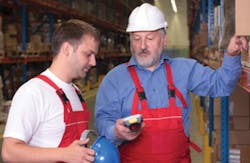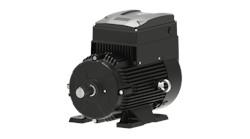Targeted training to get employees up to speed fast
Joe Waterman graduated from high school and got a job making deliveries for a local water treatment company. You have an opening for an installer, and Joe wants that job. He seems to have a good attitude and work ethic. You decide to hire him. Now you need to get him productive quickly. How do you do it?
Many organizations in the water treatment industry rely mainly on informal learning — it’s the sink or swim method. They have new hires shadow a more experienced employee and then work in the field until they figure out how to do the job (swim) or you realize they can’t hack it and you have to let them go (sink). The problem with this informal approach is that it can be haphazard and inconsistent, it takes too long and you risk them learning the wrong things. This can result in real harm to the business and its reputation in terms of customer dissatisfaction, mistakes and call backs.
On the other extreme, other organizations rely almost entirely on formal training. They take new hires through days or weeks of intensive training in a classroom or online. The problem with this formal training approach is that there is too much information to absorb at once and the new hires have no real on-the-job context to understand what they are learning. As a result, they only retain and apply a tiny percentage of that training on the job.
What is the optimal way to get office staff, service techs, installers and sales reps up to speed fast? How do you minimize call backs and rework? How do you make sure your people in the field have the skills and knowledge necessary to provide the service that makes your customers want to recommend your company to their neighbors? What would it mean for your bottom line if you could accomplish these things efficiently and economically?
Continuous Learning Process
With the new Modular Education Program launching at the end of March 2014, the Water Quality Association (WQA) is applying principles from cognitive science research on how people learn and, specifically, how to optimize the path to proficient job performance for installers, service techs and sales reps. WQA is deploying cutting edge technology, guided by those principles to provide an innovative curriculum for its members.
The key insight that has come out of cognitive science research is that people develop expertise primarily through experience. As we’ve all found from our own experience, you don’t learn a skill by just reading about it or sitting in a classroom. You have to do it and practice it. You can’t learn to ride a bike solely by reading about it or watching a video. You have to experience it. The Center for Creative Leadership surveyed organizations regarding how people learn job skills. They found that, in general, only 10 percent of learning is formal (e.g., classroom or online courses), 20 percent is informal (e.g., looking things up, asking someone, coaching) and 70 percent is experiential (on the job). The upshot is that formal training alone won’t get the job done; neither will informal learning. Instead, you need an integrated continuous learning process. But, how do you integrate learning in a systematic and effective way?
The way forward is to bring apprenticeship into the 21stcentury. Apprenticeship models have worked well for the trades (some of you are familiar with the apprenticeship model for plumbing). The problem with traditional apprenticeship is that it is labor intensive, time consuming and not very scalable. The good news is that with new mobile and cloud-based technologies — coupled with a clearer understanding of how to optimize learning from cognitive research — we can update the apprenticeship model to be more streamlined, cost-effective and scalable.
Implementing 21st century apprenticeship in the water quality industry
The WQA's Modular Education Program makes it easy to implement 21st Century apprenticeship. The new curriculum includes mobile technology that guides employees through a systematic sequence of learning activities that are aligned with required skills and competencies based on these learning guidelines:
- Create a set of practical performance goals
- Set up a systematic set of experiences
- Provide content at the teachable moment
- Reflect on the experiences
- Recognize accomplishments and achievements.
This systematic learning process is supported by a new software application developed by Cognitive Advisors. Once the competencies are loaded into the system, the program provides learning paths, tracks formal, informal and experiential learning activities, captures experiences through a mobile portfolio app, reports on progress and awards electronic badges.
The WQA began the process by bringing in members who are experts in each area of water quality. These experts identified the key competencies (knowledge and skills) that office staff, installers, service techs and sales reps need to do their jobs well. The curriculum focuses on what employees need to be able to do — practical performance goals. Then, the WQA identified a systematic set of learning experiences that will lead to the achievement of those competencies. These experiences are sequenced into learning paths that optimize the development of each set of competencies. The learning paths consist of structured on-the-job experiences that are supported by mobile performance support and coaching, short self-study online readings and online mini-tutorials.
The optimization of learning is mainly based on experience and reflection, but formal content certainly has its place. Keep in mind that formal training should be dished out in small portions, as short segments that are available on-demand to prepare for the next experience. WQA is providing formal learning, in the form of online mini-tutorials when it is needed — at the teachable moment.
This key content should be available at all times and WQA is strategically releasing this refreshed content. This information can be used in the field during teachable moments.
While experience is essential for learning job skills, it is not enough. People must also have opportunities to reflect on each experience. Reflection enables people to take lessons learned from the experience and apply them to new situations. The WQA program supports reflection by having employees record their experiences with an ePortfolio — by answering a quick question, filling out a short checklist or taking a picture of their work and submitting it to their coach or supervisor for review and discussion.
Employees are motivated to learn by having their progress and accomplishments recognized along the way. WQA’s system does this by awarding badges that employees can earn by demonstrating competence in key skills (yes, like Boy Scout badges). These electronic badges are authenticated so someone can click on a badge and see what the employee has done to earn it. The badges can be displayed on the company website or the employee can share the badges on Facebook.
Now, back to your new hire, Joe Waterman. You enroll Joe in the WQA program to learn to be an installer. Joe takes out his smartphone, looks at his learning path to see that his next learning goal is to install a piece of equipment. The learning path guides him to view an online learning module on how to install it, then to review an installation checklist from the knowledge base and finally to practice installing it at a customer site. When he is done, Joe uses his smartphone to create a portfolio entry — he takes a picture of his work, adds a brief note on the challenges he faced and geotags the customer location. He then submits his portfolio entry to his supervisor to review.
When his supervisor gets a notification from the education tracking software that Joe has completed the installation, he schedules a brief coaching conversation with Joe later that week. When Joe has demonstrated that he can successfully install that type of equipment, he is issued an electronic badge that he proudly shares on the company website and with his friends on Facebook.
With WQA’s help, you’ve implemented a 21st Century apprenticeship program that optimize Joe’s path to top notch performance in record time. He gets up to speed fast, he has few call backs and your customers are glad to recommend your company to their neighbors. Joe is proud, your customers are happy and your business is humming along.
Marty Rosenheck, Ph.D., is Chief Learning Strategist at Cognitive Advisors, a company that provides learning strategy consulting and learning software infrastructure for field service and other industries. He can be reached at [email protected].


